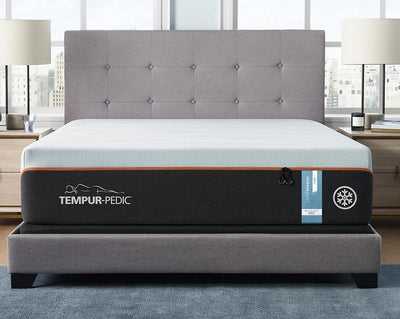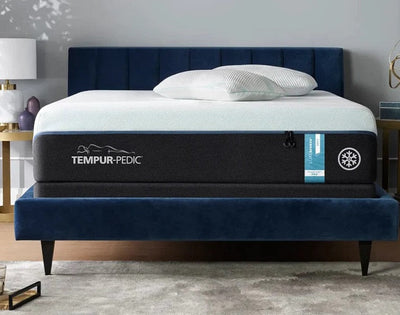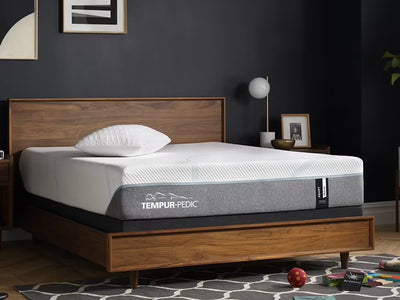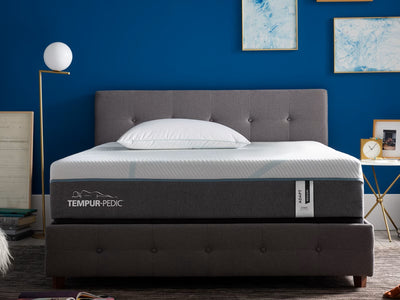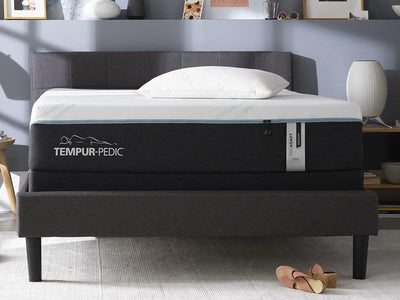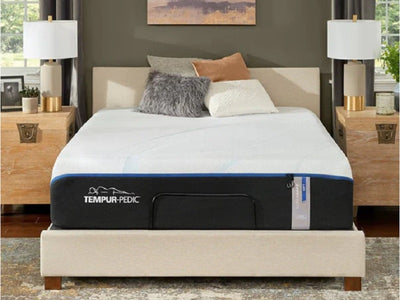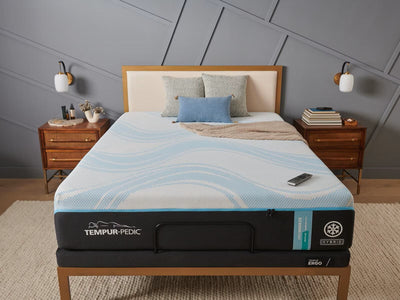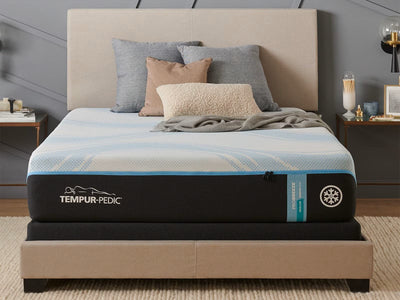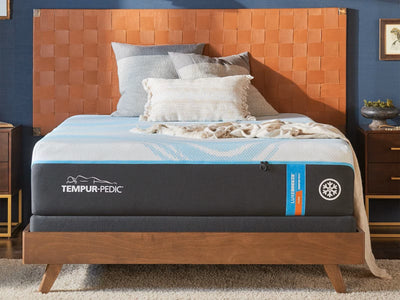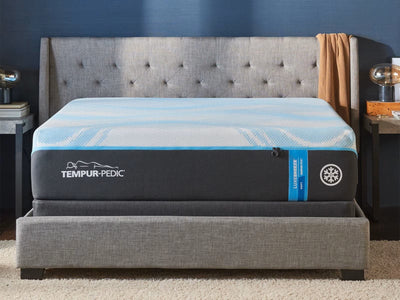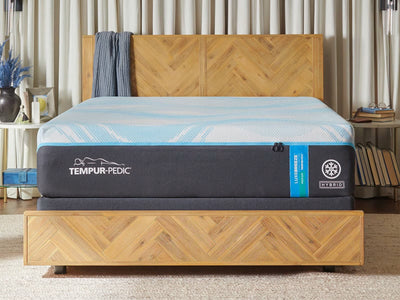Tempur-Pedic Mattresses
Regardless of your sleep challenges, whether it's tossing and turning, overheating, or dealing with a snoring partner, Tempur-Pedic® offers unique solutions designed to ensure you enjoy deep, comfortable, and uninterrupted sleep every night.
Filter and sort
What people ask about Tempur-Pedic
The investment in Tempur-Pedic mattresses can be justified by their exceptional comfort and longevity, as per the consensus of our survey participants and product testers. If you're in the market for a durable mattress that molds to your body contours and offers outstanding pressure alleviation during your rest, you might find a Tempur-Pedic mattress to be an excellent choice.
Tempur-Pedic stands out in the mattress industry for its unique use of Tempur material, an innovative foam originally engineered by NASA. This material was initially designed to absorb shock waves and enhance comfort in spacecraft seats. Tempur-Pedic has harnessed this technology to craft mattresses that provide superior comfort and pressure relief.
The Tempur foam is distinct from typical memory foam due to its high density and slower response time. This makes the mattresses adept at contouring closely to the body, effectively supporting the sleeper's natural alignment and relieving pressure points. The result is a sleep surface that adapts to each individual's shape, weight, and temperature, delivering personalized comfort and support. The unique benefits offered by Tempur material have helped Tempur-Pedic establish a strong reputation for providing quality sleep solutions.
No, Tempur-Pedic mattresses do not require a box spring. Traditional box springs are designed to provide a certain amount of "give" under a conventional innerspring mattress. However, Tempur-Pedic mattresses need a solid, sturdy base to perform optimally. This is because they are designed to deliver their signature body-conforming and pressure-relieving features, which can be compromised by the springiness of a box spring.
If you don't prefer a power base, Tempur-Pedic recommends using their specially designed flat foundations, which are created to work in synergy with their mattresses. These foundations provide the firm, unyielding support that Tempur-Pedic mattresses need to offer the maximum level of comfort and durability.
Therefore, when setting up your Tempur-Pedic mattress, consider using a solid platform, an adjustable base, or a Tempur-Pedic flat foundation to ensure the best support and lifespan for your mattress.
Tempur-Pedic mattresses are known for their exceptional durability and long lifespan, primarily due to the high-quality Tempur material used in their construction. However, like all mattresses, they can still experience wear over time. That said, sagging is not a common issue with Tempur-Pedic mattresses if properly cared for and used on a supportive base.
Over time, the memory foam in Tempur-Pedic mattresses can indeed become firmer. This is because the materials that offer comfort and support to your body, such as the memory foam and latex, are filled with air when new. This internal air suspension contributes to the mattress's ability to conform to your body and distribute weight evenly.
As you use the mattress over time, these materials naturally compress and may feel more firm, but this does not inherently lead to sagging. In fact, Tempur-Pedic mattresses have a reputation for maintaining their shape and support for a longer period compared to many other mattresses on the market.
However, if you do notice a significant or uncomfortable amount of sagging over time, it could be due to an inadequate bed base or foundation that isn't providing the proper support your mattress needs. In such cases, it might be worth checking your Tempur-Pedic warranty as the company has a robust warranty program that covers excessive sagging.
Remember, the estimated lifespan of a Tempur-Pedic mattress is about 15 years, almost double that of some other mattress brands. Thus, you can expect your Tempur-Pedic to serve you well for a significant amount of time.
Yes, a Tempur-Pedic mattress can potentially provide beneficial relief for individuals suffering from sciatica. The advanced TEMPUR-material used in these mattresses is designed to contour precisely to your body shape and weight, distributing pressure evenly across the mattress surface. This unique characteristic helps to reduce pressure points, which in turn can alleviate the discomfort associated with sciatica.
Here's what makes Tempur-Pedic potentially beneficial for sciatica:
- Pressure Relief: Tempur-Pedic's proprietary foam adapts to your body shape, weight, and temperature, providing customized support and pressure relief. This can alleviate tension on the sciatic nerve.
- Proper Alignment: Tempur-Pedic mattresses can help maintain correct spinal alignment, which is critical for relieving sciatic pain. Proper alignment can reduce pressure on the sciatic nerve and prevent it from flaring up.
- Comfort and Support: Unlike traditional innerspring or standard memory foam mattresses, Tempur-Pedic mattresses offer a balance of comfort and support that can potentially reduce the impact of sciatica symptoms.
However, it's essential to remember that what works for one person might not work for another. Personal comfort preferences and the underlying cause of your sciatica will significantly influence what type of mattress is best for you. Always consult with a healthcare provider when making decisions about sleep surfaces related to chronic pain conditions.
Tempur-Pedic mattresses are renowned for their durability and quality, often outlasting many other types of mattresses on the market. A well-maintained Tempur-Pedic memory foam mattress can provide exceptional sleep comfort for approximately 15 years. This lifespan is nearly double that of certain other mattress brands, which speaks volumes about Tempur-Pedic's commitment to quality and longevity.
However, several factors can influence the longevity of a Tempur-Pedic mattress, even given its premium build. These include:
- Use: The frequency and manner in which the mattress is used can impact its lifespan. A mattress that is used nightly by two adults will typically wear out faster than one used occasionally by a single sleeper.
- Body Weight: Heavier body weights can place more strain on a mattress, potentially reducing its lifespan. Tempur-Pedic mattresses are designed to support a range of body weights, but over time, this can still affect their durability.
- Maintenance: How the mattress is cared for can also affect its longevity. This includes regular rotation, proper cleaning, and using a high-quality mattress protector to shield against spills and stains.
- Foundation: The type of base or foundation used with the mattress can also impact its lifespan. Tempur-Pedic recommends using a firm, solid-surface, non-spring foundation or adjustable bed base.
By considering these factors and taking appropriate steps to maintain the mattress, users can extend the lifespan of their Tempur-Pedic mattress, ensuring many years of comfortable, restful sleep.
Tempur-Pedic mattresses are uniquely constructed with a one-sided design, meaning they're not meant to be flipped. This is because Tempur-Pedic layers their mattresses specifically for optimal performance, with the comfort layers on top and the support layers beneath.
This patented design is precisely engineered to allow the Tempur material to deliver its maximum performance in providing pressure relief, body contouring, and weight distribution. The advanced Tempur material is designed to maintain its shape and consistency for many years, thereby eliminating the need to flip or rotate the mattress to maintain its comfort and support.
Simply put, Tempur-Pedic mattresses are created to self-maintain, bouncing back to their original form time after time, year after year, ensuring you enjoy consistent comfort and support throughout the lifespan of the mattress.
Indeed, Tempur-Pedic mattresses can be a beneficial choice for individuals suffering from back pain. Tempur-Pedic mattresses are renowned for their use of high-density Tempur foam, which was originally designed by NASA. This foam is celebrated for its unique ability to contour to your body's shape, evenly distributing your weight, and minimizing pressure points - all of which can contribute to back pain relief.
Here are some reasons why a Tempur-Pedic mattress might be a good choice if you have a bad back:
Targeted Support: Tempur-Pedic mattresses are designed to respond to your body's unique shape, weight, and temperature, providing personalized support and alignment, which can significantly help in relieving back pain.
Pressure Relief: The Tempur material in Tempur-Pedic mattresses adapts to the body's contours and reduces pressure points that can cause discomfort and interrupt sleep. This ability to cradle the body's curves can be especially beneficial for those suffering from back pain.
Proper Spinal Alignment: Proper spinal alignment during sleep is crucial for those with back pain. Tempur-Pedic's adaptive material can help maintain the natural curvature of your spine by providing adequate support to your lower back.
Motion Isolation: Tempur-Pedic mattresses are also known for their excellent motion isolation. This means if you share your bed with a partner, their movements won't disturb your side of the bed, ensuring you have an uninterrupted sleep, which is essential for healing and pain management.
However, it's always recommended to consult with a healthcare provider or a sleep expert when choosing a mattress, especially if you have chronic back pain or other health conditions. They can provide personalized advice based on your specific needs and preferences.
While it is technically possible to place a Tempur-Pedic mattress directly on the floor, it is generally not recommended for several reasons:
1. Air Circulation: Mattresses need good air circulation to stay fresh and avoid moisture accumulation that can lead to mold and mildew growth. Placing a Tempur-Pedic mattress directly on the floor can hinder air circulation, especially in foam-based mattresses like Tempur-Pedic that tend to retain heat.
2. Damage and Dirt: A mattress on the floor is more prone to damage from dust, dirt, and potential spills. It's also more accessible to pets and may be affected by insects or pests.
3. Warranty Concerns: It's essential to check the warranty terms of your Tempur-Pedic mattress. Some manufacturers might void the warranty if the mattress isn't placed on a supportive, elevated surface.
4. Comfort and Support: Tempur-Pedic mattresses are designed to work best with certain types of bases that can provide adequate support and maintain the integrity of the mattress structure. Placing it on the floor might not offer the same level of support.
5. Health Concerns: If you have mobility issues or suffer from joint pain, getting in and out of a mattress placed on the floor might be challenging and uncomfortable.
Therefore, Tempur-Pedic recommends using a solid base or their specially designed Tempur-Pedic foundations or adjustable bases for the best performance and comfort from their mattresses. Always make sure to follow the manufacturer's recommendations for maintaining the quality of your mattress and its warranty.
Yes, a Tempur-Pedic mattress can certainly be cleaned, although it does require some specific steps to ensure it's done correctly and to prevent any damage to the material. It's important to remember that Tempur-Pedic mattresses should not be soaked in water or any cleaning solution. Here are the steps you can follow:
1. Remove and Wash the Mattress Cover: The Tempur-Pedic mattress comes with a removable cover. This cover can be unzipped and machine washed. Be sure to follow the care instructions on the tag.
2. Vacuum the Mattress: Vacuum the surface of the mattress using a handheld vacuum. This will remove any dust or debris from the surface.
3. Spot Clean Any Stains: If there are any stains on your mattress, use a mild fabric solution. Dampen a cloth with the solution and gently blot the stain. Avoid rubbing or scrubbing as it can push the stain deeper into the mattress.
4. Deodorize with Baking Soda: To freshen up the mattress, sprinkle a thin layer of baking soda over the entire surface. Let it sit for a few hours or even overnight if possible, and then vacuum it up. Baking soda is great at absorbing odors and can leave your mattress smelling fresh.
5. Let the Mattress Dry: After cleaning, let the mattress dry completely before putting the mattress cover back on. You can speed up the drying process by using a fan or a hairdryer on the cool setting, or simply let it air dry.
6. Protect Your Mattress: To prevent future stains or damage, consider using a waterproof mattress protector. This can keep your mattress clean and increase its lifespan.
Remember to always check the care instructions provided by Tempur-Pedic for your specific mattress model. Avoid using harsh chemicals, soaking the mattress, or attempting to wash the entire mattress as it can damage the foam.
Yes, even a Tempur-Pedic mattress can be susceptible to bed bugs. While the material used in Tempur-Pedic mattresses is dense, bed bugs are not deterred by the type of material a mattress is made of. They are attracted to the carbon dioxide that humans exhale, and the body warmth provided when someone is sleeping. Therefore, they can infest any kind of sleeping surface where humans are present.
However, it's worth noting that because Tempur-Pedic mattresses lack the many seams and crevices found in traditional mattresses, there are fewer hiding spots for bed bugs, making them easier to spot and treat.
Here are some tips to prevent a bed bug infestation in your Tempur-Pedic or any other kind of mattress:
1. Regular Inspection: Frequently inspect your mattress and bedding for signs of bed bugs. Look for small brown or black spots (which could be their excrement), shed skins, or the bugs themselves.
2. Clean Bedding Regularly: Wash and dry your bed linens regularly, using the hottest settings. This can kill any bed bugs present.
3. Use Protective Covers: Using a bed bug-proof mattress cover can prevent bugs from entering or exiting your mattress. It's a good layer of protection that can save you from a lot of trouble.
4. Professional Help: If you do find bed bugs, it's typically best to hire a professional pest control service to ensure they're completely eradicated.
Keep in mind, bed bugs can travel easily, often hitching a ride on clothing, luggage, or used furniture. So, it's essential to be vigilant, especially after travelling or bringing second-hand items into your home.
Yes, Tempur-Pedic mattresses can potentially be an excellent choice for individuals suffering from lower back pain. Here's why:
- Customized Support: Tempur-Pedic mattresses feature proprietary TEMPUR-material that conforms to your body shape, weight, and temperature. This unique characteristic allows the mattress to provide personalized support, aligning your spine correctly and helping to reduce lower back pain.
- Pressure Relief: The adaptive foam in Tempur-Pedic mattresses provides excellent pressure relief, helping to alleviate discomfort in sensitive areas, including the lower back.
- Balance of Comfort and Support: Unlike traditional innerspring mattresses, Tempur-Pedic mattresses offer a balance of comfort and support, which can help maintain proper posture during sleep and reduce the stress on your lower back.
It's worth noting, however, that everyone's experience with back pain is unique, and what works for one person might not work for another. It's always recommended to consult with a healthcare provider when making decisions about sleep surfaces related to chronic pain conditions.



